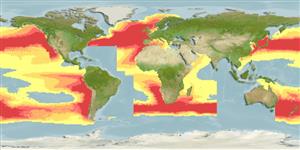Actinopterygii (ray-finned fishes) >
Perciformes (Perch-likes) >
Tetragonuridae (Squaretails)
Etymology: Tetragonurus: Greek, tetra = four + Greek, gonia = angle + Greek, oura = tail (Ref. 45335); cuvieri: Named after G.C.L.D. Cuvier 1769-1832, a founder of modern ichthyology (Ref. 6885). More on author: Risso.
Environment / Climate / Range
Ecology
Marine; bathypelagic; oceanodromous (Ref. 51243); depth range 1 - 800 m (Ref. 10823). Deep-water, preferred ?
Eastern Pacific: Aleutian Islands, Alaska to Baja California, Mexico; Chile (Ref. 9068). Western Pacific: Japan (Ref. 559), New Zealand and Australia (Ref. 6885). Western Indian Ocean: Natal, South Africa (Ref. 4415). Atlantic Ocean, including the Mediterranean (Ref. 4415).
Size / Weight / Age
Maturity: Lm ? range ? - ? cm
Max length : 70.0 cm TL male/unsexed; (Ref. 4415)
Oceanic, usually near surface; possibly near bottom. Perhaps occurs in schools. Young usually among jellyfishes or inside large salps. Feeds on jellyfishes and salps (Ref. 2850), also other soft-bodied coelenterates, ctenophores, as well as plankton. There are conflicting reports that the flesh of this species is poisonous (Ref. 11149).
Life cycle and mating behavior
Maturity | Reproduction | Spawning | Eggs | Fecundity | Larvae
Haedrich, R.L., 1986. Tetragonuridae. p. 851. In M.M. Smith and P.C. Heemstra (eds.) Smiths' sea fishes. Springer-Verlag, Berlin. (Ref. 4415)
IUCN Red List Status (Ref. 115185)
CITES (Ref. 94142)
Not Evaluated
Threat to humans
Reports of ciguatera poisoning (Ref. 4690)
Human uses
More information
ReferencesAquacultureAquaculture profileStrainsGeneticsAllele frequenciesHeritabilityDiseasesProcessingMass conversion
Tools
Special reports
Download XML
Internet sources
